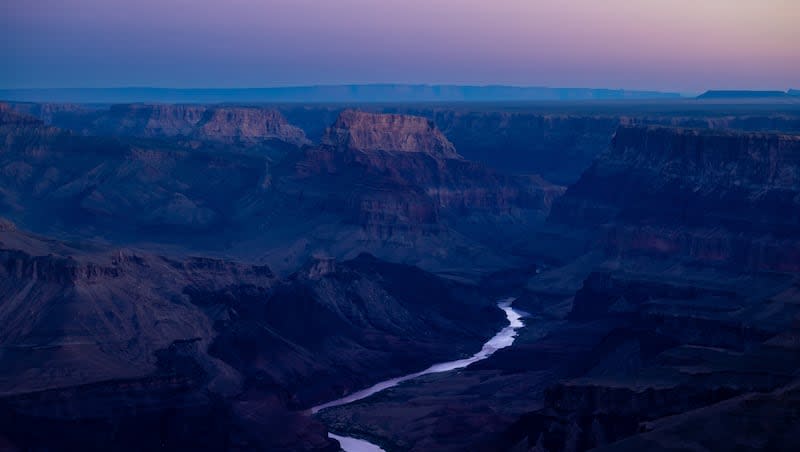New efforts by federal government aim to help the struggling Colorado River

The Colorado River is drying up.
Decades of drought and endless diversions have destroyed the river to a shadow of itself.
What happens next for a river that helped build the West and provides water for 40 million people and irrigates the “Bread Basket” of America has to come with some teeth.
On Tuesday, the U.S. Bureau of Reclamation announced a short-term solution to a long problem, announcing conservation efforts with voluntary agreements designed to conserve more water.
“The identified preferred alternative reflects a historic, consensus-based proposal — secured by the Biden-Harris administration in partnership with the seven Colorado Basin states — that will lead to at least 3 million acre-feet of system water conservation savings through the end of 2026, when the current guidelines expire,” the U.S. Bureau of Reclamation announced.
In its supplemental environmental impact statement, the bureau said the strategy embraces reduction of releases from Lake Powell down to 6 million acre-feet of water if the reservoir is projected below 3,500 feet over the subsequent 12 months. This would be implemented across a range of elevations in Lake Mead and is in addition to the already existing 2007 interim guidelines on shortages and contributions that are made under the Lower Basin Drought Contingency Plan.
Reclamation announced three new system conservation implementation agreements in California that will conserve water in Lake Mead, including agreements with:
• Bard Water District, in cooperation with Metropolitan Water District: This agreement commits up to 18,090 acre-feet of conserved water through 2026.
• Coachella Valley Water District: This agreement commits up to 30,000 acre-feet of conserved water through 2026.
• Palo Verde Irrigation District, in cooperation with Metropolitan Water District: This agreement commits up to 351,063 acre-feet of conserved water through 2026.
In total, the bureau said, 24 conservation agreements across California and Arizona are expected to conserve up to 1.58 million acre-feet of water through 2026, with an investment of up to $670.2 million from the Inflation Reduction Act, which is part of a larger spending package of $4.6 billion to address the historic drought across the West.
“The big picture remains the same. The past two decades have culminated in critically low reservoir conditions in the Colorado River Basin and across the West, putting a strain on people and businesses, our wildlife and their habitats — their very livelihood,” said Bureau Commissioner Camille Calimlim Touton. “The prolonged drought crisis is driven by effects of climate change, including extreme heat and low precipitation. In turn, severe drought conditions exacerbates wildlife risk, impacts crop yields and disrupts entire ecosystems, increasing the stress on communities and our landscapes.”
She emphasized these are important reductions that will help the Colorado River, but more must be done in the arena of conservation.
“Importantly, this historic agreement has given us some breathing room to focus on the long term,” she said.
The Colorado River, described as the hardest working river in the West, is shared among seven states, including Utah.
While the Upper Colorado Basin has yet to be impacted by cuts, states have been carving out their own solutions to help downstream recipients and to preserve power generation at Glen Canyon Dam at Lake Powell. The Upper Basin has been tasked with the contractual obligation to allow 7.5 million acre-feet of Colorado River water to flow downstream to its partners each year — and now that has been reduced by 1.5 million acre-feet.
Amy Haas, executive director of the Colorado River Authority of Utah, said upper basin states are continuing to make reductions.
“Separate from but complementary to the Upper Division States Alternative for Post-2026 Operations of Lake Powell and Lake Mead, Utah and its sister states of Colorado, New Mexico and Wyoming intend to undertake parallel commitments to preserve the ability to release water from Lake Powell, including conservation activities that are voluntary, temporary and compensated, as well as actions to allow for releases from upstream reservoirs in accordance with existing law,” she said.
Saving the dam water
Hydroelectric power produced by the dam’s eight generators helps meet the electrical needs of the West’s rapidly growing population. With a total capacity of 1,320 megawatts, Glen Canyon produces around 5 billion kilowatt-hours of hydroelectric power annually, which is distributed by the Western Area Power Administration to Wyoming, Utah, Colorado, New Mexico, Arizona, Nevada and Nebraska. In the immediate vicinity, without the dam, the lights in Page, Arizona, would go dark.
Critics of Lake Powell have argued it should be drained, that Glen Canyon should be restored to its natural state and the Colorado River should be allowed to flow unhindered. At the very least, they argue for millions in new money to be invested in infrastructure lest catastrophe ensue.
The Upper Basin, through a series of complex water management steps, released water from upstream Flaming Gorge and Blue Mesa to keep the water flowing, delivering 1.6 million acre-feet of water to the ailing Lake Powell.
It still sits at just a little over one-third of its capacity.
The bureau is expected to finalize its planned cuts in the coming weeks with an official record of decision.

